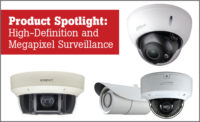
|
| Video surveillance technology changes often, and so do its requirements. Think outside of monitor resolution restrictions. |
Keven Marier’s article “The ‘16x Growth’ Business of Ultra High-Definition Surveillance,” which appeared in the February issue of Security Magazine, argues that without hardware technology partners to make ultra high-definition displays, workstations, video adapter cards and software, there is no real way to take advantage of the high-definition megapixel surveillance cameras.
Marier’s argument is based on analog thinking which dictates that television scan lines must be matched to camera resolution for optimal picture quality – a notion that simply no longer applies when dealing with high-definition surveillance solutions that combine network video management software and multi-megapixel camera technology. Today’s high-definition surveillance solutions deliver full situation awareness and indisputable image detail for more reliable, useable and effective video surveillance footage.
The industry’s move towards increased camera resolution has already had tremendous benefit for end users, who are able to cover wider areas in greater detail using fewer high-definition cameras. Today, high-definition surveillance solutions protect and monitor an array of diverse locations with superior image clarity including stadiums, retail environments, casinos, critical infrastructure, transportation stations and more. The result is lower installation costs and indisputable image detail, leading to faster response times, reduced investigation times and superior overall protection.
While monitor resolution is a notable metric for a command center scenario that requires a large data wall to display critical information including camera views, maps, weather, or other information, it is no longer a barrier in many surveillance settings. Gone are the days when system designers must match the resolution of the camera to the monitor or exceed standard monitor resolutions to gain the benefits of high-definition surveillance. In fact, most of today’s high-definition surveillance systems work with off-the-shelf display technology. Viewing high-definition surveillance footage on desktops, laptops, iPhones, iPads and Android devices is already a reality.
Monitor resolution is not a key consideration in most surveillance applications because the primary purpose of ultra high-definition cameras – which can reach up to 29 megapixels – is to enable users to zoom into large scenes to view exact details, which can be accomplished on any monitor resolution. Used mainly to cover vast areas in ports, stadiums, transportation, logistics and critical infrastructure applications in high detail, ultra high megapixel cameras deliver the best image quality possible by leveraging software solutions that send only the requested portions of captured images to operator workstations.
Providing immediate savings in transmission bandwidth, these solutions deliver the full value of the highest megapixel camera using low-cost conventional workstations with resolutions as low as 1.3 MP. By leveraging leading imaging, hardware, data compression and information technology, these solutions maximize system performance using any off-the-shelf display technology.
In the past, analog surveillance cameras required a complete room of matrix hardware to drive monitor walls. Not only does this scenario require additional equipment and consume more space, these solutions are also costly because each card requires its own client license. With high-definition systems, security personnel can create virtual matrices using software to control and display video on any number of local or remote physical and virtual monitors. A virtual matrix can connect an unlimited number of clients and create video copies that are essentially free, delivering 24/7 access to surveillance footage in a space-saving and cost-efficient manner. A virtual matrix delivers higher flexibility and scalability than an analog matrix, which was required in legacy systems to connect cameras to corresponding monitors.
Another major difference between an analog-based surveillance solution and a high-definition surveillance system using multi-megapixel cameras is the role that the video footage can ultimately play as evidence. In analog systems, video footage is commonly used as secondary evidence to support cases that are built on other factors including scene analysis and eye witness accounts. With high-quality image clarity and powerful zooming capabilities to pinpoint even the smallest detail, combining advanced management software and multi-megapixel cameras, this video can be used as primary evidence, leading to enhanced incident resolution, successful prosecution and reduced operational costs.
Analog thinking simply no longer applies when dealing with high-definition surveillance solutions that combine network video management software and multi-megapixel camera technology. The benefits of ultra high-definition surveillance solutions that combine powerful software and multi-megapixel camera technology are already in use in businesses ranging from educational institutes to stadiums to logistics companies. High-definition surveillance solutions deliver full situation awareness and indisputable image detail for more reliable, useable and effective video surveillance footage for use today.
Do you have any questions, comments, tips or best practices that you'd like to share with the industry? Email us! Send your feedback to Claire Meyer, Security's associate editor, at meyerc@bnpmedia.com



